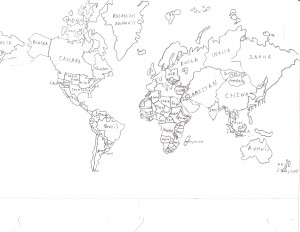United Earth
Dec 25th, 2009 by admin
This back story picks up after the breakup of the United States.
Taken from “The Definitive History of the Planet Earth, Volume II – The Middle Era: Struggle for Planethood.”
This excerpt deals with the early struggle to unite the peoples of the planet.
At the time of the first Conference on World Peace, for the first time perhaps in history, there were no armed conflicts in progress. There were truces, cease fires, economic skirmishes and cold wars, but no actual shooting. The General Assembly chose six steering members, one from each conference. Those steering nominated a council of 20 which was approved by the Assembly. Then the council of 20 got down to the business of presenting the steering members with a plan for maintaining the peace. Once the steering members signed off they would present it to the General Assembly for approval. A two thirds majority would be needed to pass.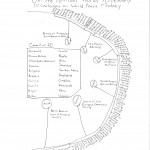
On one extreme, radicals called for the first steps towards real world federation with a popularly elected assembly distributed across national borders. The other extreme called for rolling back most of the UN’s powers and a return to the “free marketplace of international relations.”
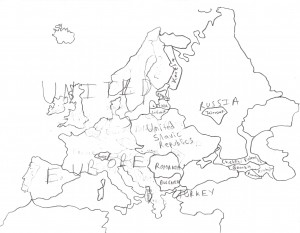 What was truly expected was a series of resolutions on the ongoing disputes, and a proposal to streamline decision-making perhaps suggesting some expanded permanent council to conduct daily business to insure peace. The European Union was the biggest drag. Europe was the only continent not united under a UN peace-keeping body. It maintained its peace by the treaty of European Union. It fought tooth and nail against further world federalism. The EU was the main actor in this, because it almost had all of Europe under its control, and certainly wanted it. The aim was not just to be a peacekeeping body but a supergovernment in the old style that had recently fallen apart in North America and previously in central Asia.
What was truly expected was a series of resolutions on the ongoing disputes, and a proposal to streamline decision-making perhaps suggesting some expanded permanent council to conduct daily business to insure peace. The European Union was the biggest drag. Europe was the only continent not united under a UN peace-keeping body. It maintained its peace by the treaty of European Union. It fought tooth and nail against further world federalism. The EU was the main actor in this, because it almost had all of Europe under its control, and certainly wanted it. The aim was not just to be a peacekeeping body but a supergovernment in the old style that had recently fallen apart in North America and previously in central Asia.
Additionally, Israel and Switzerland refused to recognize any intermediary between themselves and the UN and hence had no representation on the steering committee.
The council continued without any direct action, however peace reigned and borders were maintained. The UN took over the Moon Missions in order to run them non-nationally. The Luna City colony was founded and operated by the UN.
—
Eventually the 20-member council’s continuing series of resolutions led to the development of the United Earth project. The UE was proposed to replace the UN as a more centralized world government rather than a representational assembly of world governments.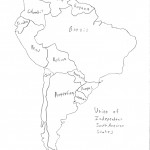
By this time South America had set up a continental parliament which unified markets and currency, similar to Europe’s. The defense organizational group, United Sovereign African Nations, had become United Africa, with a continental parliament. The Confederation of Asian Nations had a steering committee to coordinate member state’s policies. The EU also operated a Pan-European council with non EU members to do the same things.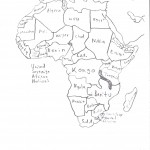
The North American Union of Sovereign States (NAUSS), set up after the Peace of Houston, was the least formal, with no standing councils or parliaments. It was similar to the Pacific Alliance, which was very decentralized and also wasn’t considered a governmental union.
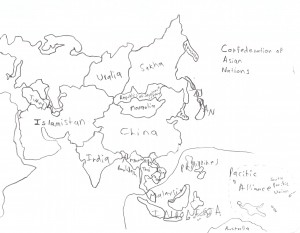 The Pacific Alliance did have a standing council however. That council had been created sometime after the formation of the NAUSS. Hawaii had not attended either the Peace of Vancouver or the Peace of Houston, though in separate negotiations, the US had recognized its independence as part of the Peace of Houston, in exchange for leasing Pearl Harbor. Inspired by the formation of NAUSS, Hawaii had teamed with Papua New Guinea to model the South Pacific Union of Island Nations (SPU) after it. The SPU then pushed Australia to form a similar Pacific Alliance with New Zealand, Indonesia, The Malay Republic, and others in the area.
The Pacific Alliance did have a standing council however. That council had been created sometime after the formation of the NAUSS. Hawaii had not attended either the Peace of Vancouver or the Peace of Houston, though in separate negotiations, the US had recognized its independence as part of the Peace of Houston, in exchange for leasing Pearl Harbor. Inspired by the formation of NAUSS, Hawaii had teamed with Papua New Guinea to model the South Pacific Union of Island Nations (SPU) after it. The SPU then pushed Australia to form a similar Pacific Alliance with New Zealand, Indonesia, The Malay Republic, and others in the area.
South America and Africa pushed strongly for the UE. Europe and Asia were willing to compromise for a less powerful and less centralized version. The Pacific Nations remained neutral. Only the North American nations actively opposed the plan, led by the Texas Republic’s outright refusal to consider it.
After two years, Peru led a coalition to force a vote on UE. Each UN member nation would cast its own vote, regardless how any overarching regional organization felt. In other words the African Union might favor the plan, but Libya could still vote no if it wanted to. Few compromises had been made from the original proposal, and most experts gave it little chance of passing. The assent of two thirds of all possible voters was necessary to pass the proposal. This meant any nation that abstained had the effect of voting no. Even so, UE came within 11 votes of passing.
With some further compromise, Peru knew it could swing some votes from Europe, Asia, and even North America. With 8 abstentions, theoretically only 3 no votes would have to be changed. But some African nations had constitutions requiring abstention on any world government proposal.
There were 65 yes votes, 30 no votes and 8 abstentions. This chart covers the reasons and positions of the no voters and abstainees.
| Country | Vote | Explanation | Chance of change |
| Switzerland | Abstained | Tradition of neutrality prevents them from voting on this issue | No |
| Israel | No | Not a chance. At odds with UN right now. | No |
| Pampas | No | Slight chance of change, but mostly voting on principle | – |
| Phillipines | No | Could be swayed with minor compromises | yes |
| Australia | Ab. | Fairly firm in opposition. Some headway could be made. | – |
| Bangladesh | No | Aligned with mid-east in opposition against union | No |
| Kamchatka | No | Isolationist parliament | No |
| Sakha | No | Isolationist parliament | No |
| India | No | Bowing to public pressure for isolationism and alignment with Islamistan. | No |
| Islamistan | No | Leads mid-east opposition to union. Against many mid-east principles. | No |
| Zulu | Ab. | Constitutional requirement | No |
| Bantu | Ab. | Constitutional requirement | No |
| Adalia | Ab. | Constitutional requirement | No |
| Eritrea | No | Constitutional requirement | No |
| Benin | Ab. | Constitutional requirement | No |
| Egypt | Ab. | Constitutional requirement | No |
| Azerbaijan | No | Need significant changes. | – |
| Armenia | No | Will not vote yes unless Azerbaijan does. | – |
| Gruzinia | No | Amenable to compromise but not very willing. | – |
| Chechnya | No | Isolationist parliament | No |
| Tatarstan | No | Isolationist parliament | No |
| Russia | No | Require some minor compromises | Yes |
| Bulgaria | Ab. | Objected to minor wordings | Yes |
| Romania | No | Government willing, but UE is unpopular with voters | – |
| United Slavic Republics | No | Required slight compromise on specific issues regarding eastern Europe | Yes |
| Lithuania/Latvia/Estonia | No | Public opinion | No |
| Karelia | No | Last-minute surprise no vote. | Yes |
| Albania | No | Isolationist government | No |
| Texas Republic | No | Actively campaigning to limit UN powers | No |
| Midwestern States of America | No | Need compromises to ensure local sovereignty | Yes |
| Southern States of America | No | Require big compromises on local sovereignty | – |
| Quebec | No | Specific protections for culture required before assent | – |
| Mormon Nation | No | Rejected over religious tolerance issues | No |
| Kulaalitt Nunaat | No | Actively campaigning to limit UN power | No |
| California | No | Small compromises needed | Yes |
| Alaska | No | Distrustful of expansion of UN powers | – |
Seven of the no votes seemed like they could easily be swayed to yes. Big compromises or diplomatic overtures would be needed for nine of the no votes. Peru needed to convince four of those nine votes to change. Distrustful nations like The Pampas and Alaska alongside ones with oppositional public pressure like Romania would be the hardest to change. That left Australia, Azerbaijan, Armenia, the SSA, and Quebec as the best bets. Convince four of those five and UE would pass.
Australia – The largest Pacific Alliance country wanted special autonomy for its Coast Guard, placing it outside the proposed UE military arrangements under the full control of the Australian government. Allowing Australia this autonomy would certainly cause many other countries to ask for special autonomy for their armed forces. Peru hoped to talk Australia into forming a Sea Patrol for safety and immigration that wouldn’t be a military force.
Azerbaijan (and Armenia) – Similar to Australia, Azerbaijan wanted to keep their border military. Of course, so did every other no vote. Armenia wanted the same. Peru hoped they could get both nations to agree to a phased drawdown of national border troops, to be replaced by UN (UE) troops along the border to soften tensions.
SSA – The Southern States wanted several trade protections which would actually be violations of its own North American accord if put in place. This was considered to be the hardest one to resolve. Peru hoped to placate them with substitute incentives but considered it a long shot.
Quebec – The Quebecois actually wanted a paragraph added insuring that at no time would the union of nations allow 1. Canadian rights to Quebec land or 2. Change to the official language of Quebec or any threat to Quebec culture. Only Canada had objected to this paragraph, though many considered it a bad precedent to allow.
In the end, Peru won over Australia, Azerbaijan and Armenia. They also won Quebec, with the addition of the language they wished for, but that meant Canada threatened to abstain leaving the UE one vote short. Romanian public pressure had only gotten worse forcing it out of the running altogether. Gruzinia seemed to be the best bet now that the Azerbaijan/Armenia issues ahd been resolved. The Pampas and Alaska were invited to a summit with Gruzinia in Lima, Peru. The Pampas and Gruzinia unexpectedly came with authorization form their governments to agree to a compromise. After the talks Alaska said it would definitely abstain if not vote yes.
The final vote came out 77 yes, 7 abstentions and 19 no.
Of the no votes, 10 said they would actively resist a United Earth. Israel said it would refuse to join UE but would not actively resist it. In anticipation of this, Peru had proposed and got approved a provision for some business to remain under the auspices of the UN which Israel would agree to attend. This new UN would consist of a committee of delegates from the membership of the UE and one delegate from Israel. Most countries that voted no due to public pressure felt they could still safely join the UE since they had voted no. A United Earth became a reality. –See the United Earth Fact Sheet.
Upon passage of the UE resolution however, Bangladesh, Kamchatka, Sakha, India, Islamistan, Chechnya, Tatarstan, Albania, Texas and KN refused to join the UE and formed a new world organization called the Free Nations of Earth, or simply, Free Earth. Worldwide civil war threatened.
The back story continues with the Cold War between UE and FE
This page has the following sub pages.
